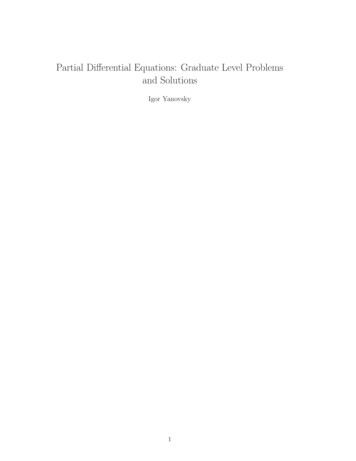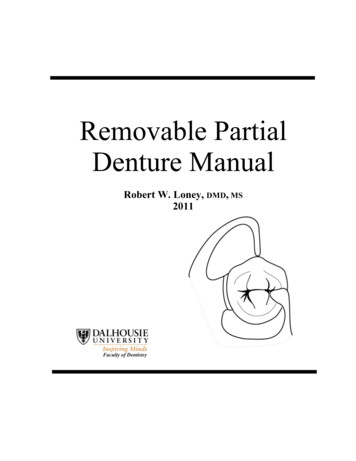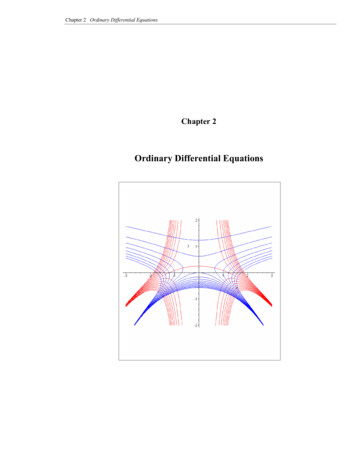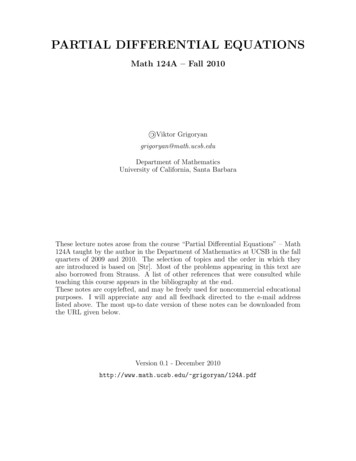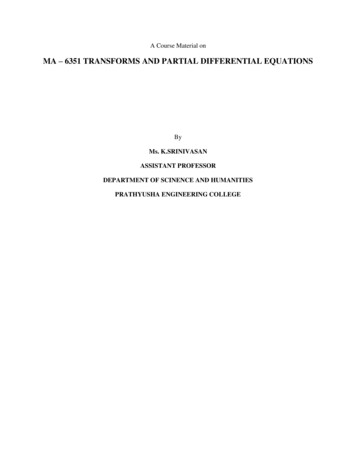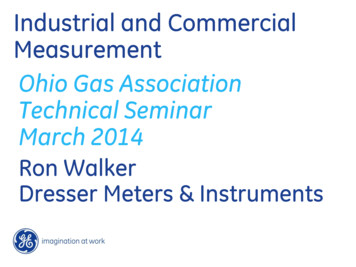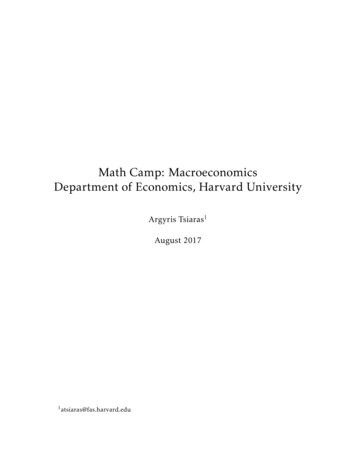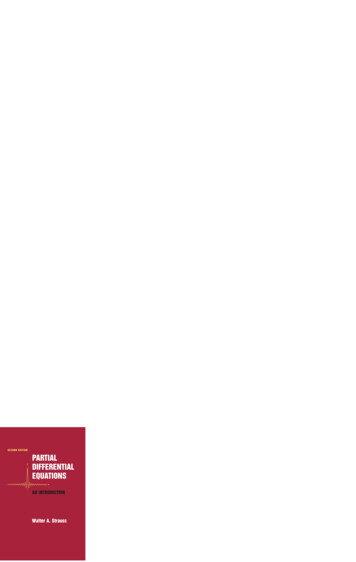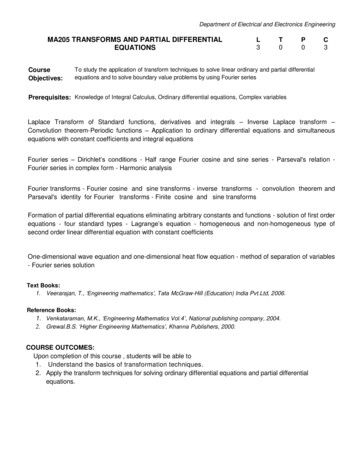
Transcription
Department of Electrical and Electronics EngineeringMA205 TRANSFORMS AND PARTIAL DIFFERENTIALEQUATIONSCourseObjectives:L3T0P0C3To study the application of transform techniques to solve linear ordinary and partial differentialequations and to solve boundary value problems by using Fourier seriesPrerequisites: Knowledge of Integral Calculus, Ordinary differential equations, Complex variablesLaplace Transform of Standard functions, derivatives and integrals – Inverse Laplace transform –Convolution theorem-Periodic functions – Application to ordinary differential equations and simultaneousequations with constant coefficients and integral equationsFourier series – Dirichlet’s conditions - Half range Fourier cosine and sine series - Parseval's relation Fourier series in complex form - Harmonic analysisFourier transforms - Fourier cosine and sine transforms - inverse transforms - convolution theorem andParseval's identity for Fourier transforms - Finite cosine and sine transformsFormation of partial differential equations eliminating arbitrary constants and functions - solution of first orderequations - four standard types - Lagrange’s equation - homogeneous and non-homogeneous type ofsecond order linear differential equation with constant coefficientsOne-dimensional wave equation and one-dimensional heat flow equation - method of separation of variables- Fourier series solutionText Books:1. Veerarajan, T., ‘Engineering mathematics’, Tata McGraw-Hill (Education) India Pvt.Ltd, 2006.Reference Books:1. Venkataraman, M.K., ‘Engineering Mathematics Vol.4’, National publishing company, 2004.2. Grewal.B.S. ‘Higher Engineering Mathematics’, Khanna Publishers, 2000.COURSE OUTCOMES:Upon completion of this course , students will be able to1. Understand the basics of transformation techniques.2. Apply the transform techniques for solving ordinary differential equations and partial differentialequations.
Department of Electrical and Electronics EngineeringEE201 DC MACHINES AND TRANSFORMERSL3T1P0CourseObjectives:This course aims to equip the students with a basic understanding of DC machinesand Transformer fundamentals, machine parts and help to gain the skills for operating DCmachines and Transformers . The course also equips students with ability to understandand analyze the equivalent circuits of DC machines and Transformers.Prerequisites:Engineering Physics and Basic Electrical EngineeringC4Principles of Energy conversion – basic magnetic circuit analysis Faradays law of electromagnetic induction– singly and doubly excited magnetic field systems – torque production in rotating machines and generalanalysis of electro mechanical system.DC Generator – construction, principle of operation – emf equation – types Characteristics commutation armature reaction.DC motor – principle of operation – torque equation – types – electrical & mechanical characteristic–starting– speed control – various testing – braking.Transformers – principle of operation – types – basic construction – equivalent circuit - regulation andefficiency – auto transformer.Three phase transformer connection-Scott connection – all day efficiency - Sumpner's test - paralleloperation of transformersText Books:1. Dr. P.S. Bhimbra, ‘Electrical Machinery’, Khanna Publications, 7th Edition, 2007.2. Nagrath, I.J.and Kothari, D.P., ‘Electrical Machines’,Tata McGraw Hill Education Private Limited PublishingCompany Ltd., 4th Edition, 2010.Reference Books:1. Arthur Eugene Fitzgerald and Charles Kingsley, ‘Electric Machinery’, Tata McGraw Hill Education Publications,6th Edition, 2002.2. Vincent Del Toro, ‘Electrical Engineering Fundamentals’, 2nd Edition, Prentice hall Publications, 2003.3. Parkar Smith, N.N., ‘Problems in Electrical Engineering’, 9th Edition, CBS Publishers and Distributers, 1984.COURSE OUTCOMES:Upon the completion of the course, The student will be able to1. Understand the constructional details and principle of operation of DC machines and Transformers.2. Analyze the performance of the DC Machines under various operating conditions using their variouscharacteristics.3. Evaluate the performance of Transformers using phasor diagrams and equivalent circuits.4. Select appropriate DC motor as well as to choose an appropriate method of speed control for anyindustrial application
Department of Electrical and Electronics EngineeringEE203 CIRCUIT THEORYL3T1P0C4CourseObjectives:To provide the key concepts and tools in a logical sequence to analyze and understandelectrical and electronic circuits.Prerequisites:Higher secondary mathematical concepts such as solution of ordinary differential equations,calculus, matrix algebra and elementary concepts of physics such as electricity and magnetismFundamental concepts of R, L and C elements, DC circuits, series and parallel circuits - loop and nodalanalysis, A.C circuits - complex impedance - phasor diagram, real and reactive power - loop and nodalanalysis applied to AC circuits.Voltage source –current source transformations,ac circuits, star-delta transformations.Various Network theorems and applications to dc andResonance in series and parallel circuits, self and mutual inductances, coefficient of coupling - dotconvention - analysis of coupled circuits.Three - phase star a n d d e l t a c i r c u i t s wit h balancedpower factor calculations.and unbalanced loads power measurements -Time response of RL, RC and RLC circuits for step and sinusoidal inputs.Text Books:1. Hayt, W. H, Kemmerly J. E. & Durbin, ‘Engineering Circuit Analysis’, McGraw Hill Publications, 8th Edition,2013.2. Charles K. Alexander, Matthew N. O. Sadiku, ‘Fundamentals of Electric Circuits’, McGraw-Hill Publications,3rd Edition, 2007.Reference Books:1. Joseph.A. Edminister, ‘Electric Circuits - Schaum's outline series’, McGraw Hill Publications,6 t h E d i t i o n , 2003.2. Robins & Miller, ‘Circuit Analysis Theory and Practice’, Delmar Publishers, 5th Edition, 2012.COURSE OUTCOMES:Upon completion of this course the students will be able to,1. Understand the technical representation of common electrical systems.2. Analyze and compute the time domain behavior of linear (AC and DC) electric circuits with singleor multiple power sources.3. Compute the performance of AC Networks (1 port) which may be 1-phase or 3-phase using phasoranalysis.4. Understand flow of real and reactive power components in AC systems.5. Analyze simple electro-magnetic circuits.
EE205 ELECTRON DEVICESCourseObjectives:L3T0P0C3To educate on the construction and working of common electronic devices and toprepare for application areas.Prerequisites: Semiconductor materialsSemi-conductors- charge carriers, electronsconductors – Hall effectandDiodes – PN junction – current equation – junctionZener, tunnel, Schottky sincapacitanceintrinsicand extrinsic semi-- breakdown characteristics,– Characteristics – analysis of CB, CE, CC amplifierUnipolar devices – FET, MOSFET, UJT and Opto-Electronic devices – theory and characteristicsRectifiers and switched mode power supplies – theory and design, filter circuits, applicationsText Books:th1. David, A.Bell, ‘Electronic Devices and Circuits’, PHI, 5 Edition, 2008.2. Millman and Halkias, ‘Electronic Devices and Circuits’, McGraw-Hill International student Edition, 5th Reprint1993.Reference Books:th1. Allen Mottershead, ‘Electronic Devices and Circuits-An Introduction’, PHI, 18 Reprint, 2006.th2. Albert Malvino and David J Bates, ‘Electronic Principles’, McGraw Hill, 7 Edition, 2007.COURSE OUTCOMES:Upon completion of this course , students will be able to1. Understanding the semiconductor physics of the intrinsic, p and n materials and various devicesand characteristics.2. Analyze simple diode circuits under DC and AC excitation.3. Analyze and design simple amplifier circuits using BJT in CE,CC and CB configurations4. Understand the analysis and salient features of CE, CC & CB amplifier circuits.5. Understand the construction and characteristics of FET, MOSFET and UJT
Department of Electrical and Electronics EngineeringEE207 DIGITAL ELECTRONICSCourseObjectives:L3T0P0C3This subject exposes the students to digital fundamentalsPrerequisites: Basics of Electron DevicesReview of number systems, binary codes, error detection and correction codes.Digital LogicFamilies – Introduction to RTL, DTL, TTL, ECL and MOSL families – wired and operation,characteristics of digital logic family – comparison of different logic familiesCombinational logic - representation of logic functions – SOP andPOSformsK-maprepresentations – minimization using K maps - simplification and implementation of combinationallogic – multiplexers and demultiplexers – code converters, adders, subtractors.Sequential logic- SR, JK, D and T flip flops – level triggering and edge triggering–countersasynchronous and synchronous type – Modulo counters – Shift registers – Ring counters.–Synchronous Sequential Logic circuits-state table and excitation tables-state diagrams-Moore andMelay models-design of counters-analysis of synchronous sequential logic circuits-state reduction andstate assignment.Asynchronous sequential logic circuits-Transition table, flow table – race conditions – circuits withlatches, analysis of asynchronous sequential logic circuits – introduction to design –implication tablehazards-programmable logic array and devices.Text Books:1. Morris Mano.M, ’Digital logic and computer design’, Prentice Hall of India, 3rd Edition, 2005.2.Donald D. Givone, ‘Digital Principles and Design’, Tata McGraw Hill, 1st Edition, 2002.Reference Books:1. Tocci R.J.,Neal S. Widmer, ‘Digital Systems: Principles and Applications’, Pearson Education Asia,2014.2.Donald P Leach, Albert Paul Malvino, Goutam Sha, ‘Digital Principles and Applications’, TheMcGraw Hill, 7th edition, 2010.COURSE OUTCOMES:Upon completion of this course , students will be able to1. Interpret, convert and represent different number systems2. Manipulate and examine Boolean algebra, logic operations, Boolean functions and theirsimplification3. Design and analyze combinational and sequential logic circuits
Department of Electrical and Electronics EngineeringME231 THERMODYNAMICS AND MECHANICS OF To achieve an understanding of principles of thermodynamics and to be able to use itin accounting for the bulk behavior of the simple physical systems.To provide in-depth study of thermodynamic principles, thermodynamics of state, basicthermodynamic relations, Properties of pure substancesTo enlighten the basic concepts of air standard cyclesTo provide basic awareness about fluid properties and its flowTo impart knowledge about hydraulic machinesConcepts and principles dealing with thermodynamic cycles, thermodynamic relations andgeneralized charts, mixtures of fluids, chemical reactions, chemical and phase equilibrium,thermodynamic aspects of fluid flow.Basic knowledge of mathematics.Basic concepts: Thermodynamic equilibrium, quasi-static process, zeroth law, work and heat interactions,first law for a cycle and a process, steady flow processes, second law statements, reversibility, Carnottheorem, Clausius inequality, entropy principle.Heat engines: Otto, diesel and dual cycles, Brayton cycle with regeneration, inter cooling reheat, JouleThompson effect, Rankine cycle, reheat and regenerative cycle, properties of ideal gas, Stirling and EricsoncyclesAvailable energy: Availability and irreversibility, properties of pure substances, phase equilibrium diagrams.Classification of fluids and their physical properties, Fluid statics, manometers, pressure on submergedbodies. Basics of fluid properties - Vapour Pressure – Pressure at a point its variation – Measurement withPiezo meter, manometers and gauges - Continuity equation in one dimension – Bernoulli’s equation –Venturi meters and Orificie metersPumps – General principles of displacement and Centrifugal pumps – Efficiency and Performance Curvesof Pumps – Cavitation in Pumps – Turbines – Efficiency – Governing of turbinesText Books:1. Gordan Van Wylen, Richard Sonntag., ‘Fundamentals of Classical Thermodynamics’, John Wiley and Sons,19942. Yunus A.Cengel and Michel A.Boles, ‘Thermodynamics: An Engineering Approach’, McGraw-Hill HigherEducation, 20063. T.R.Banga and S.C.Sharma, ‘Hydraulic Machines’, Khanna Publishers, 2004Reference Books:1. Kothandaraman. C.P., A Course in Thermodynamics and Heat Engines', Dhanpat, Rai and Sons, 1992.2. Nag, P.K., Engineering Thermodynamics', Tata McGraw Hill, 1997.3. R.K.Rajput, ‘Thermal Engineering’, Laxmi publications, 2006.4. Nagarathnam, S. ‘Fluid Mechanics’, Khanna Publishers, New Delhi, 1995.5. Dr.R.K.Bansal ,‘A text book of Fluid Mechanics and hydraulic machines’ ,Laxmi Publications(P) Ltd,2005COURSE OUTCOMES:Upon the completion of the course, the students will be able to1. Understand the fundamentals of first and second laws of thermodynamics and their application to awide range of systems.2. Familiarize with calculations of the efficiencies of heat engines and other engineering devices.3. Familiarize the construction and principles governing the form of simple and complex one-componentphase diagrams such as pressure-temperature , volume-temperature & and pressure-volume and thesteam tables in the analysis of engineering devices and systems.4. Calculate various fluid flow parameters5. Determine the optimum working conditions for hydraulic machines
Department of Electrical and Electronics EngineeringEE 209 DC MACHINES AND TRANSFORMERS LABORATORYL0T0P3C2CourseObjectives:The main objective of the course is to give the students an insight into the constructional detailsof the dc machines and transformers with a view of better understanding of their workingprinciples. The course also equips the students to test and evaluate the performance of various dcmachines and single phase transformers by conducting appropriate experiments.Prerequisites:Basic knowledge in electric circuit analysis, constructional details and operational principles ofvarious dc machines and transformers.List of ExperimentsA demonstration of the static and rotational electrical machines (constructional details) is oughtto be done in an introductory class.1. Open circuit and load characteristics of DC shunt/compound generator2. Swinburne's test and Speed control of DC shunt motor3. Load test on DC shunt motor4. Load test on DC series motor5. Open circuit and short circuit test on single phase transformer6. Load test on single phase transformer7. Sumpner's test8. Parallel operation of single phase transformer9. Electrical braking in DC shunt motor10. Three phase transformer connectionsMini-projectCOURSE OUTCOMES:Upon completion of the course, the students will be able to1. Interpret the constructional details of the DC machines and Transformers and alsounderstand the significance of different connections of three phase transformers2. Estimate or test the performance of any DC machine (shunt, series or compound) andsingle phase transformer, by conducting suitable experiments and report the results.3. Experiment and analyze, the various speed control and braking techniques for dc motors4. Develop simulation models and prototype modules in view of implementing any controltechnique upon dc motors and single phase transformers for various applications
Department of Electrical and Electronics EngineeringEE211 CIRCUITS AND DEVICES LABORATORYCourseObjectives: Prerequisites:L0T0P3C2To understand and analyze the basic theorems of Circuit theoryUnderstand and analyze series & parallel circuits and measurement of single and threephase power.Understand and analyze different applications of diode and characteristics of Transistor.Basic electrical and electronics elements (R, L, C, diode, Transistor)List of Experiments1. Verification of Thevenin’s and Maximum Power Transfer Theorem.2. Verification of KCL, KVL and Super Position Theorem.3. Basic operation of AC R-L-C Series & Parallel Circuit4. Measurement of Power and Power Factor in Single Phase AC circuits5. Verification of Resonance in Electrical Circuit.6. Verification of 3-Phase Star & Delta Connection.7. Design of full wave Rectifiers (Centre –tapped and Bridge).8. Design of Clipping and Clamping circuits9. Volt-ampere characteristics of rectifier diode and Zener diodes as a voltage regulator circuit.10. Characteristics of CE configuration of BJTCOURSE OUTCOMES:Upon completion of the course, the students will be able to1. Verify the network theorems and operation of typical electrical and electronic circuits.2. Choose the appropriate equipment for measuring electrical quantities and verify the same fordifferent circuits.3. Prepare the technical report on the experiments carried.
To study the application of transform techniques to solve linear ordinary and partial differential equations and to solve boundary value problems by using Fourier series Prerequisites: Knowledge of Integral Calculus, Ordinary differential equations, Complex variables Laplace Transform of Standard functions, derivatives and integrals - Inverse .

